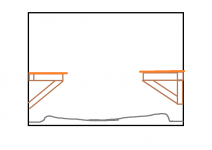Jmacpherson
Member
- Joined
- Jun 9, 2016
- Messages
- 215
Hi all
My current small home "shop" is getting cramped and I'm thinking of moving to the back of the garage.
I mentioned on a previous post once before that our garage is below street level and that the driveway angles down steeply.
I won't go into all the details but to say the floor of the garage is designed and shaped to allow any water to drain towards the garage door and the drains outside it. There is a channel along the back of the floor and sides which also angle down and to the front.
There is some moisture in winter and the floor can get damp in the channels - the original renovators hit the water table (long story)
I've added a rough sketch drawn in paint - no I'm not going to get any awards for it but it should portray the floor/channels and work bench idea
To overcome the floor which isn't flat and potentially damp I'm thinking of "floating"work benches along the back wall and a portion of the side walls.
I would use a horizontal ledger bolted to wall (masonry wall), pressure treated would be best but not always straight. Would painted pine work just as well?
Then have perpendicular supports attached to the rear ledger using either toe nail screwing or pocket holes.
Then have a front ledger to keep it all together.
Then under each horizontal support piece have an angle support going back to the wall
The last part I'm not sure if using brackets and mounting to the wall will be strong enough or if vertical supports should be attached to the wall and then screw the angle supports to that?
Will my design/idea be strong enough etc?
Thanks
John
My current small home "shop" is getting cramped and I'm thinking of moving to the back of the garage.
I mentioned on a previous post once before that our garage is below street level and that the driveway angles down steeply.
I won't go into all the details but to say the floor of the garage is designed and shaped to allow any water to drain towards the garage door and the drains outside it. There is a channel along the back of the floor and sides which also angle down and to the front.
There is some moisture in winter and the floor can get damp in the channels - the original renovators hit the water table (long story)
I've added a rough sketch drawn in paint - no I'm not going to get any awards for it but it should portray the floor/channels and work bench idea
To overcome the floor which isn't flat and potentially damp I'm thinking of "floating"work benches along the back wall and a portion of the side walls.
I would use a horizontal ledger bolted to wall (masonry wall), pressure treated would be best but not always straight. Would painted pine work just as well?
Then have perpendicular supports attached to the rear ledger using either toe nail screwing or pocket holes.
Then have a front ledger to keep it all together.
Then under each horizontal support piece have an angle support going back to the wall
The last part I'm not sure if using brackets and mounting to the wall will be strong enough or if vertical supports should be attached to the wall and then screw the angle supports to that?
Will my design/idea be strong enough etc?
Thanks
John

